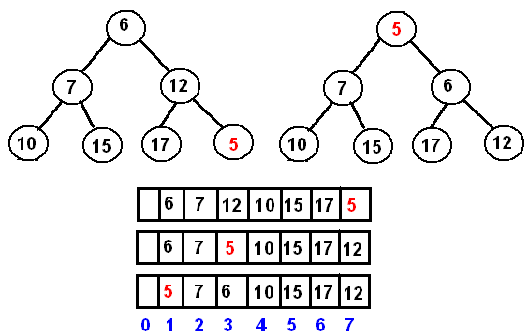
A binary heap is a complete binary tree which satisfies the heap ordering property. The ordering can be one of two types:
Throughout this chapter the word "heap" will always refer to a min-heap.

In a heap the highest (or lowest) priority element is always stored at the root, hence the name "heap". A heap is not a sorted structure and can be regarded as partially ordered. As you see from the picture, there is no particular relationship among nodes on any given level, even among the siblings.
Since a heap is a complete binary tree, it has a smallest possible height - a heap with N nodes always has O(log N) height.
A heap is useful data structure when you need to remove the object with the highest (or lowest) priority. A common use of a heap is to implement a priority queue.

The root is the second item in the array. We skip the index zero cell of the array for the convenience of implementation. Consider k-th element of the array, the
See Heap.java. for implementation details.

The following code example demonstrates the algorithm
public void insert(Comparable x)
{
if(size == heap.length - 1) doubleSize();
//Insert a new item to the end of the array
int pos = ++size;
//Percolate up
for(; pos > 1 && x.compareTo(heap[pos/2]) < 0; pos = pos/2 )
heap[pos] = heap[pos/2];
heap[pos] = x;
}
The worst-case runtime of the algorithm is O(log n), since we need at most one swap on each level of a heap on the path from the inserted node to the root.
Example. Given an array {3, 1, 6, 5, 2, 4}. We will sort it with the HeapSort.
1. build a heap 1, 2, 4, 5, 3, 6
2. turn this heap into a sorted list
deleteMin
1, 2, 4, 5, 3, 6 swap 1 and 6
6, 2, 4, 5, 3, 1 restore heap
2, 6, 4, 5, 3, 1
2, 3, 4, 5, 6, 1
deleteMin
2, 3, 4, 5, 6, 1 swap 2 and 6
6, 3, 4, 5, 2, 1 restore heap
3, 6, 4, 5, 2, 1
3, 5, 4, 6, 2, 1
deleteMin
3, 5, 4, 6, 2, 1 swap 3 and 6
6, 5, 4, 3, 2, 1 restore heap
4, 5, 6, 3, 2, 1 restore heap
deleteMin
4, 5, 6, 3, 2, 1 swap 4 and 6
6, 5, 4, 3, 2, 1 restore heap
5, 6, 4, 3, 2, 1
deleteMin
6, 5, 4, 3, 2, 1
Priority queues are useful for any application that involves processing elements based on some priority. It supports two major operations insert(object) and deleteMin(). The elements of a priority queue must be comparable to each other, either through the Comparable or Comparator interfaces. We have introduced a priority queue when we discussed Java's collection classes. In this chapter we reinforce priority queue operations with a binary heap. Using a heap to implement a priority queue, we will always have the element of highest priority in the root node of the heap.

The reason we re-implement a priority queue is to improve its effiiciency. When we implemented a priority queue with an array or a linked list, the efficiency of some operations were O(n).
| insert | deleteMin | remove | findMin | |
| ordered array | O(n) | O(1) | O(n) | O(1) |
| ordered list | O(n) | O(1) | O(1) | O(1) |
| unordered array | O(1) | O(n) | O(1) | O(n) |
| unordered list | O(1) | O(n) | O(1) | O(n) |
Using a binary heap, the runtime of both the deleteMin and insert operations is O(log n).
| insert | deleteMin | remove | findMin | |
| binary heap | O(log n) | O(log n) | O(log n) | O(1) |